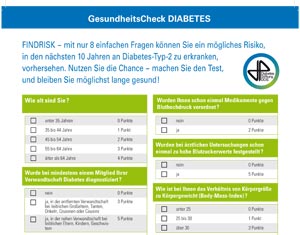Diabetes prevention
A campaign of BA-Service-Haus Nürnberg

Diabetes does not strike everyone - but every 10th
In Germany there are about 7 million people with diabetes. The number of people with undiscovered diabetes is about 2 - 3 million.
What is diabetes?
In type 2 diabetes (more than 90% of all people with diabetes, formerly called adult-onset diabetes, now affecting more and more younger people), the effect of the hormone insulin in body cells is reduced (insulin resistance), always coming with insulin deficiency.
Findrisk-Test
With a few simple questions, you can assess your risk.


